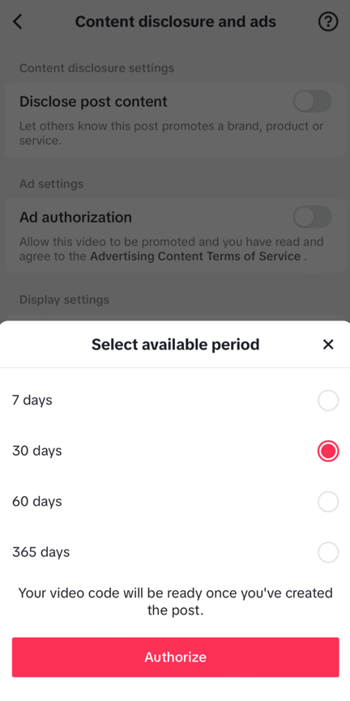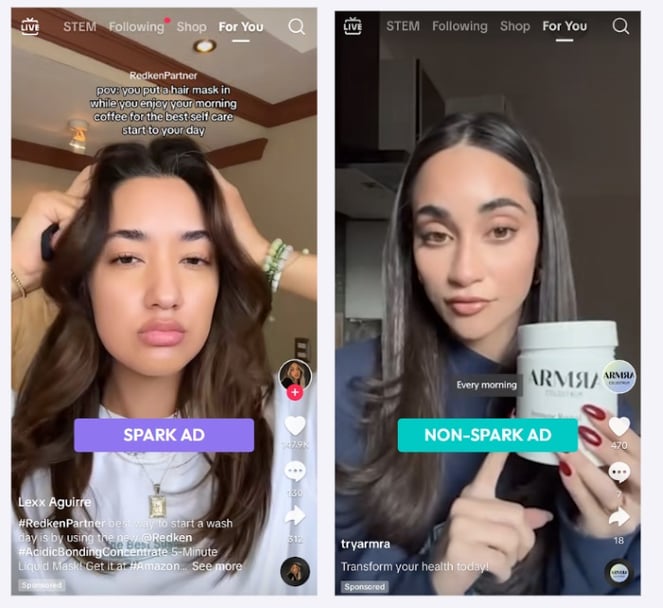TikTok Whitelisting: How to Whitelist Creator Content on TikTok
TikTok whitelisting with Spark Ads instantly transforms creator videos into top-tier ads. We explain how to whitelist TikTok content and why brands...
TikTok Spark Ads turn your brand's UGC into high-performing paid promotions. We explain how to set up Spark Ads and ways to optimize your TikTok campaigns.


Chances are you can’t escape TikTok Spark Ads right now.
This applies to marketers, brands and everyday creators alike.
But it’s not a big surprise with how much TikTok hypes up the high performance of creator ads.
This includes higher conversion rates, more engagement and massive reach.
And we’ve seen firsthand how unfiltered Spark Ads have the go-to format for CPG brands.
Is squeezing more out of your influencer content by running Spark Ads on your radar? Good!
In this post, we’ll cover:
Skip to Section 👇TikTok Spark Ads vs. Non-Spark Ads |
Spark Ads are TikTok promotions that transform creators’ organic videos into paid ads.
To create a Spark Ad, creators must provide ad permissions to brands with a unique Spark Ad video code. This process is commonly known whitelisting (or allowlisting).
Below is a snapshot of some Spark Ads from beauty brands via TikTok’s Creative Center.

Source: TikTok
Note these posts’ high performance and the fact that they’re simple smartphone videos.
Hint, hint: that’s no coincidence!
Most TikTok Spark Ads resemble raw content because unfiltered videos outperform “polished” ads. New reporting from TikTok really drives this home:
And this is exactly why TikTok’s motto for brands is “Make TikToks, not ads.”
With so many types of TikTok ads, what makes the Spark format so special?
Here are the key details unique to Spark Ads versus non-Spark Ads:
Here’s what authorizing a Spark ad via video code looks like for creators:


One of the biggest distinctions between Spark Ads vs. non-Spark ads is the presentation of the ad by the creator’ @handle.
And to be clear, the Spark Ads format is technically not the only type of creator ad on TikTok.
Some brands will run UGC ads with TikTok posts that are never posted organically (“dark posts”).
Check out the Spark Ad example below for reference. The Spark Ad on the left is presented from the creator’s TikTok account whereas the ad on the right is presented by a brand.

The trade-off for these types of creator ads really boils down to performance. As we said, there's a reason why the top-performing ads on your #FYP are presented by creators instead of brands.
To learn more about the distinction between types of creator ads, make sure to check out our breakdown of influencer allowlisting, whitelisting and dark posting.
Here’s the thing about creating Spark Ads: you don’t really have to “create” anything!
For marketers with limited and time and resources (hint: all of us), this is great news. Most of the Spark Ad creation process is about coordinating with creators for content rights.
Below is a simple, 60-second explanation of how to set up Spark ads from our recent allowlisting webinar. For a more detailed how-to, check out this step-by-step breakdown.
And that’s that!
The recent (and rapid!) growth of TikTok ad budgets for brands speaks for itself.
Of course, seeing results with any type of paid social campaign doesn’t happen by accident.
Brands can’t make videos Spark Ads themselves with the help of content creators. That said, you are in control of the types of videos and creators you promote.
To wrap things up, here are some tips and best practices for Spark Ad videos.
The whole "Make TikToks, not ads" mantra isn't just a cliche.
Based on our firsthand experience and the app's recommendations, Spark Ads that resemble raw and organic videos tend to perform the best.
Unlike branded creatives where you're expected to nitpick every little detail, you have to be able to let creators cook. This is especially true as you can’t edit Spark Ad captions or details.
We’ll say it all the time: polished content typically does not translate to strong Spark Ads!
Just take a peek at the Spark Ads on your #FYP. Chances are you’ll see simple videos that look like they were published by a friend with a smartphone versus a brand with a massive production budget.

Source: TikTok
But the fact that these videos aren't pretty and polished is exactly what makes them so powerful.
This is another reason to collaborate with micro-influencers on TikTok who have a strong pulse on organic content trends to engage audiences. From more video views to higher engagement rates, the benefits of creator-centric ads are proven versus non-Spark Ads.
“How long should I run Spark Ads?”
There’s no one-size-fits-all answer here.
However, rarely do brands run the same Spark Ads for months at a time.
That’s because performance decay is a documented phenomenon for creator ads on TikTok. The app recommends running no fewer than 3-5 creatives per Spark Ad group. TikTok also recommends updating creatives weekly to avoid ad fatigue.
As noted in our recent UGC advertising Q&A, many brands will rapidly cycle through videos for testing and typically won’t run the same ads for too long. Think weeks versus months.
All of the above is something to keep in mind with the authorization duration of your Spark Ads.
For example, brands that run Spark Ads through Statusphere’s platform set a standard authorization period of 60 days. Likewise, our platform is built to help brands run Spark Ads at scale so you never run out of authentic influencer content to promote as ads!
Food for thought: 50% of the impact of a TikTok ad happens within its first two seconds.
As is the case with any piece of TikTok content, hooks are critical to stop viewers from scrolling. That’s why many Spark Ads have premises or tell stories that make us want to watch until the end.
A few TikTok Spark Ad hooks include:
Even with longer-form ads, the first few seconds are make-or-break.
This is all the more reason to consider turning your best organic posts into UGC ads. If a video hooks viewers and drives organic engagement then it’s poised to do the same as a paid promotion.
The boom of TikTok SEO is just getting started.
As more and more TikTok users treat the platform like a personalized product search engine, both organic posts and Spark Ads are crucial to maximizing your visibility in TikTok search.
Tapping into relevant TikTok keywords represents a smart way to do exactly that. TikTok’s Creative Center is a goldmine of data to help you understand trending terms, pain points and ad ideas relevant to your industry.

Source: TikTok
Weaving these details into your Spark Ads and targeting makes perfect sense.
However, note that you can’t edit captions or details of a piece of organic content. So getting these keywords in requires explicit instructions in your creative briefs.
This is yet another reason for brands to scale Spark Ads with Statusphere. Our platform makes it a cinch to provide subtle creative direction to micro-influencers without sacrificing creative freedom. This means your ads can hit all the right beats for social search while still feeling totally authentic.
If you're already doing influencer marketing campaigns on TikTok, testing Spark Ads is a no-brainer.
But despite their simple setup, running creator ads at scale can be a time-sink if you're doing it DIY.
From wrangling video codes to negotiating with creators, there's a lot of potential time wasted. This is especially true if you want to scale and optimize your Spark Ad campaigns beyond a few creators.
All the more reason to let Statusphere's micro-influencer marketing platform do the heavy lifting.
Our software matches brands and creators based on 250+ unique, first-party data points to help you get authentic UGC on autopilot. Coupled with our Instant Spark Ads feature, brands can whitelist content at scale ASAP. That's because we help you:
Since we only match you with vetted influencers from our creator community, you're more likely to generate content that aligns with Spark Ads. You can also upload your own creators to our platform.
.png?width=500&height=491&name=SparkAds-1%20(1).png)
Want to learn more about how our software works? Get in touch with our team of experts to see how we can scale your micro-influencer marketing and supercharge your Spark Ad campaigns.
The key difference between TikTok Promote and Spark Ads is that Promote involves boosting your content whereas Spark Ads involves promoting a creator’s content.
TikTok Promote involves “boosting” one of your own videos short-term (for up to seven days). The Promote feature is a streamlined way to send fast traffic to your videos with very limited setup. For example, Promote defaults your campaign options to TikTok’s default targeting where you pay for a specific # of viewers per day.
On the flip side, Spark Ads are full-blown TikTok ad campaigns that involve running a creator’s video as an ad presented from the creator’s account.
This duration of a Spark Ad is set by the creator and is tied to their ad authorization code. This timeframe can range from 7 to 365 days. The default timeframe is 30 days.
Note that creators can extend the approval period of their video codes if necessary.
How long your Spark Ads last is also dependent on your ad budget and how long you want to run a video as an ad depending on its performance. For example, you may decide to put more spending behind a Spark Ad that’s gaining momentum after a few weeks. On the flip side, you may cut a campaign short because of performance decay.
Depends on your brand’s goals!
In terms of TikTok’s specific advertising objectives, Spark Ads can be aligned with all three of the platform’s main categories (Awareness, Consideration and Conversion).
Sample outcomes and KPIs for Spark Ads based on those objectives include:
The definition of what a “dark post” is has evolved over the years. On TikTok, this could mean two types of videos:
However, Spark Ads are organic videos published by creators that were previously posted before being run as an ad. In short, “sparking” a video means taking an organic post and making it a paid one. Simple as!
To learn more, check out our post on influencer allowlisting versus dark posting.
For general TikTok ads, videos can between 5 and 60 seconds. TikTok’s blanket recommendation is to make video ads between 9 and 15 seconds.
However, TikTok does not apply the same rules to Spark Ads (which can be up to 10 minutes long).
Longer (60+ seconds) Spark ads are becoming more and more common across TikTok but what’s “optimal” depends on your industry, audience and creators. This is part of why TikTok recommends a “testing phase” for any long-term video ad campaign.
As of February 2024, TikTok’s minimum ad group budget is $20 (and $50 per campaign).

TikTok whitelisting with Spark Ads instantly transforms creator videos into top-tier ads. We explain how to whitelist TikTok content and why brands...
What do the best TikTok Spark Ads have in common? Below we share seven Spark Ad examples highlighting how TikTok UGC translates into awesome brand...
TikTok authorization codes are a key piece of promoting Spark Ads. Below we explain where to access Spark Ad codes in TikTok and how to generate them...
Be the first to know about the latest tools, trends and strategies in influencer marketing for brands.